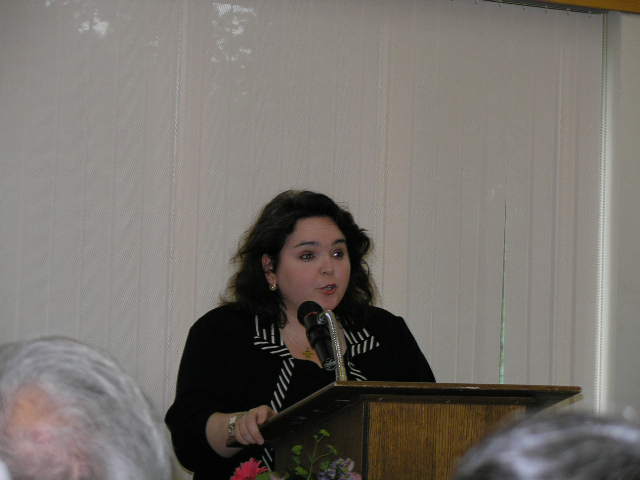The Journalist Who Believed Catholic Christianity to Be True
Kathryn Jean Lopez, of National Review Online, began her speech — beginning day three of the Portsmouth Institute’s conference on William F. Buckley, Jr. — by stating that she would not have described WFB as a “Catholic journalist,” because both descriptors were so thoroughly integrated into his persona, and she seemed genuinely awed that he plainly and directly incorporated religious beliefs in his writing. Her first example was his handling of a question on Satan, which she asked us to imagine being posed on Hardball: Stream, download (1 min, 26 sec).
Lopez read, as well, an extended excerpt from a WFB column in the ’90s decrying the taping of a murder suspect’s Catholic confession to a priest as “the end of the line” to “fascism”: Stream, download (3 min, 20 sec). The point came up again, during the Q&A, when an audience member asked the outcome of the controversy, and Kathryn promised to post the answer in the Corner on Monday. Of course, being a blogger, my Anchor Rising co-contributor Andrew Morse had googled the matter and let Ms. Lopez know that the district attorney had ended up apologizing. The case apparently became quite a row, with the defense ultimately seeking to use the tape (raising questions about whether the suspect had known to expect the recording) and the courts disallowing it, although not going quite as far as the local diocese requested and destroying the tape.
I’ve seen no indication, through quick online research, to indicate that Bill Buckley played a role beyond that typically inhabited by a columnist in that case, but as Lopez suggests, his death has left somewhat of a void where previously we all might have expected an additional, trusted, and authoritative opinion on matters of interest to those who explicitly undertake, share, or are incidentally interested in the contemporary Catholic mission. What, she wonders, would he have said of President Obama’s rhetoric when speaking at the Notre Dame graduation? Stream, download (48 sec).
A couple of notable (or, rather, especially notable) segments came during Kathryn’s Q&A. One is her response to conference organizer Jamie MacGuire’s question about her experience with Buckley as a young NR employee in which she described something that came up repeatedly during the several days devoted to the man: his investment in human capital. Stream, download (4 min, 16 sec). She suggests that WFB’s investment in and support for others extended even when they moved beyond the reach of his immediate projects, such as National Review, and sees the workings of his Christianity in that tendency. I see, as well, his larger project of building a movement of which NR was a central part; if the movement is the thing, one doesn’t want to ghettoize the soldiers in a single publication, but to send them out into the world.
A second notable exchange began with New England Cable News Reporter Gregory Wayland’s relation of his experience producing stories on the anniversary of Humanae Vitae (video) and embryonic stem cell research (video). On the first, he (and Kathryn) stated some surprise that it had been acknowledged as newsworthy. On the second, he expressed that he’d felt pressure to lessen the prominence of a scientist who researches and supports adult stem cell research. The question to Lopez was, in Wayland’s words, how to deal with “the well-worn trough down which the waters of journalism flow lined by very definite assumptions which are the received wisdom of the journalistic community.” Stream, download (3 min, 39 sec).


Jordan Christian, Baptist’s Travel Destination where Jordan is a modern country with an ancient culture, a land of which visitors can walk through the valleys, hills and plains whose names have become part of human history by virtue of the simple deeds and profound messages of prophets who walked the land and crossed its rivers during their lives. Many of the sites where they are said to have performed miracles or reached out to ordinary people have been identified, excavated and protected, and are now more easily accessible to visitors. Excavations of the earliest settlement from the days of Christ and John the Baptist have revealed at least three plastered baptism pools, a system of water pipes and channels to carry water to and from the site, and associated domestic and other structures. Ancient writers and pilgrims called the fresh spring at the site of Elijah’s Hill both John the Baptist’s Spring and Elijah’s Spring. The later fifth to sixth century settlement from the Byzantine era was a substantial walled monastery, comprising plastered pools, water cisterns, and at least three churches and other buildings with plain white and colored mosaic floors, some with crosses in the mosaics. One church mosaic inscription mentions Rotorius as the `head of the monastery`. The Byzantine writers Jerome and Eusebius mentioned `Bethabara beyond the Jordan` in the fourth century as a pilgrimage destination where people went to be baptised. Helena, the mother of Emperor Constantine, is to have crossed the Jordan River and visited Elijah’s Hill and the cave where John the Baptist lived, and built a church there to commemorate him. Stone and mud structures on the summit of Elijah’s Hill and on the adjacent hills to the south and east date from the mid-to-late Ottoman period (16th-18th centuries), when Greek Orthodox monks established… Read more »